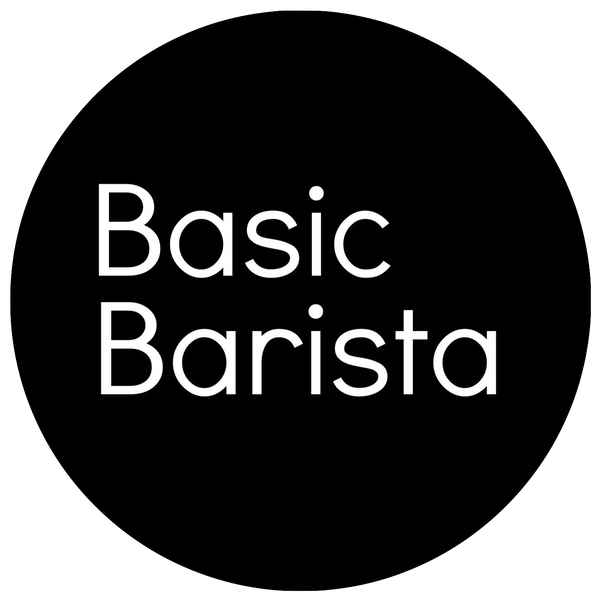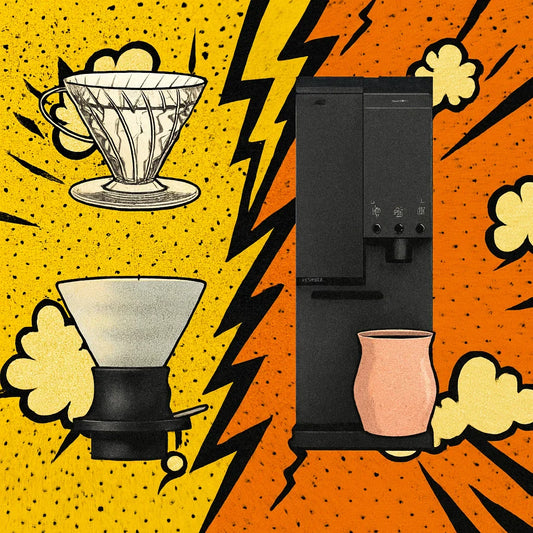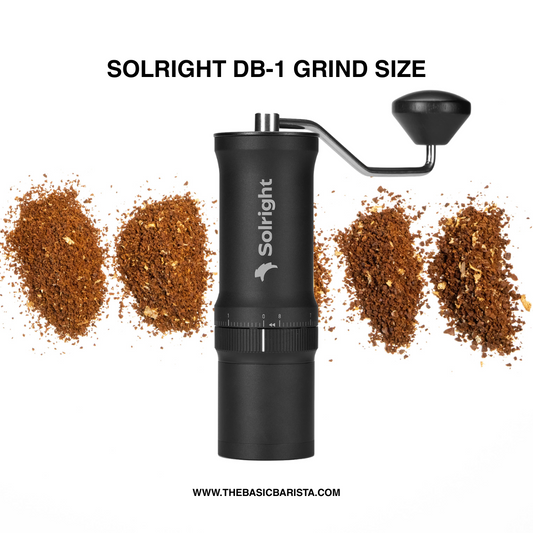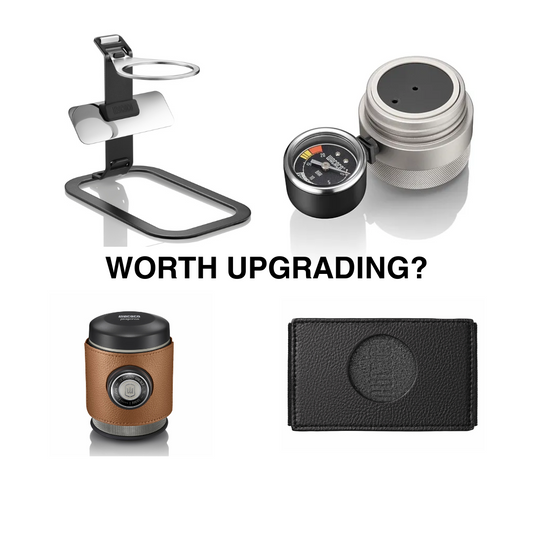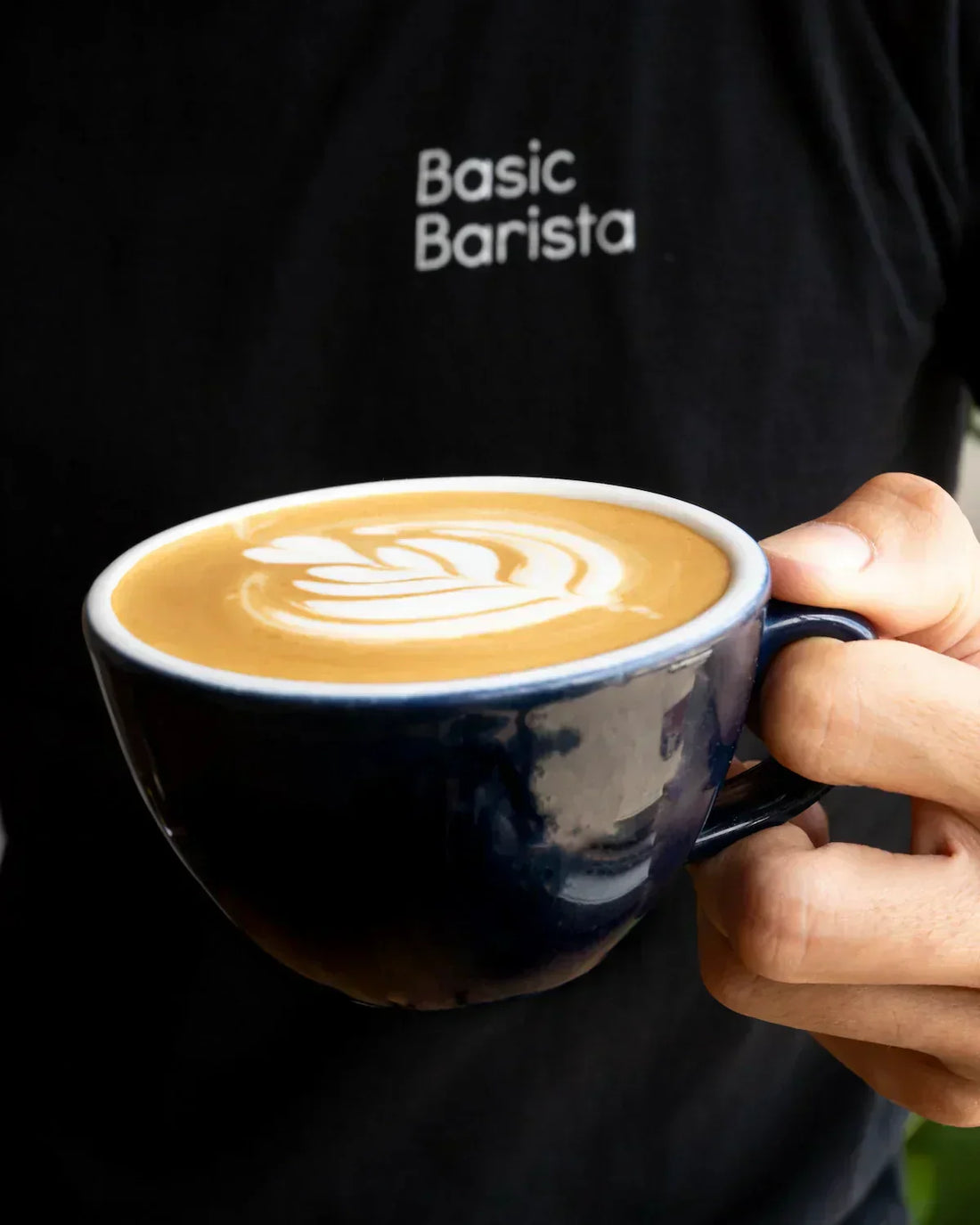
Types of Australian Coffees Baristas Need To Know
Share this article
Aussies love their coffee, but even more than coffee Aussies love to customise their coffee orders! If you're a beginner barista or just looking for a refresher we've covered the most popular coffee orders, customisations and tips to get you confident before you've even made your first coffee.
Australian Coffee Menu Explained
Australia has a large and ever growing coffee menu, with baristas expected to know how to correctly prepare everything from espresso's to flat whites. Knowing which cups to use for each drink, coffee to milk ratio's, and the proper milk texture to use for each is vital in preparing these drinks.
While most cafes have their slight variations to the below chart it's still a useful resource to have on hand when learning to become a barista.
Download the below chart by clicking the link and saving to your camera roll, this way you can quickly refer to the chart when dialing in coffees and designing your coffee menu.

Download Australian Coffee Recipe Table
Black Coffees You Need To Know
Black coffee is the most unadulterated expression of the coffee bean, no milk, no sugar (usually), just coffee and water. These drinks highlight the origin, roast profile, and brewing method more than any milk based coffee can.
Whether it's the concentrated slap in the face of an espresso or the delicate clean cup of a pour over coffee. Black coffees are increasing in popularity as more roasters are starting to pay more attention to single origins and filter coffees. Offering pour over or single origins in your cafe offer an experience to customers who want to try the full spectrum of flavour that coffee has to offer. In this section, we’ll walk through the most common black coffee styles you’ll find on an Australian cafe menu, how they’re made, and what sets each of these drinks apart.

Espresso
The foundation of almost all milk based coffees, espresso itself is a concentrated shot of coffee made by forcing hot water through finely ground coffee under pressure.
A standard espresso shot has a 1:2 Coffee To Water Ratio and is about 25-30ml which usually takes within 20-30 seconds to extract. Served in a small ceramic espresso cup or depending on the cafe a small espresso glass cup, it’s known for its intense flavour, rich crema, and syrupy body. Perfect on its own or as the base of other drinks.
When making espresso for milk based coffees it's important to use a coffee that has been roasted for milk, this also goes for serving espresso on it's own. While many roasters will usually just say 'Espresso Roast' or 'Filter Roast', some roasters go into further detail stating specifically 'Espresso or Milk'. You can always clarify how your coffee is intended to be served with your coffee supplier.

Ristretto
Ristretto is prepared the exact same as espresso's with the major difference being the ratio, while espresso has a 1:2 ratio, ristresso has a much shorter coffee to water ratio of 1:1. If you're using 20g of coffee as your dose you extract until you reach a 20g brew weight of coffee.
Ristretto's rely on a shorter amount of water being pushed through the puck of coffee and inherently take less time to extract. You can usually expect a ristretto to be extracted in around 15-25 seconds range.
Ristrettos taste thicker and have a stronger flavour with less bitterness and a rounder sweetness compared to espresso, and cafes tend to use ristrettos when a barista wants to showcase the sweetness or complexity of a particular roast, or when using a lighter roast that may become too sharp or acidic when pulled as a traditional espresso.

Lungo
While you don't see too many Lungo's around these days and we thought it would be worth mentioning. 'Lungo' in Italian translates to Long, referring to the longer extraction time and ratio of coffee to water. While Ristrestto is the shortest with a 1:1 ratio and Espressos sit in the middle at a 1:2 ratio, Lungo's are on the other extreme and have a 1:3 coffee to water ratio.
Due to the bigger ratio, Lungo shots are sometimes preferred by those who find espresso too intense or want a longer drink without adding milk or water. While not as common on Australian cafe menus as long blacks or flat whites, lungos may be offered in European influenced cafes or can be requested as a milder black coffee option.

Long Black
A Long Black is made by pouring a double espresso 2x 30ml shots over hot water about 120-160ml. The reverse of an Americano which pours the hot water over the espresso, this method preserves the crema and yields a rich, strong black coffee with full bodied flavour. It’s a popular choice in Australia and is typically served in a 200-220ml ceramic coffee cup.

Batch Brew
Batch brew refers to drip coffee made in a commercial coffee machine, often in large quantities for cafes. It involves water slowly passing through a bed of medium-coarse coffee grounds, typically brewed into a carafe. It has an extremely lighter body than espresso, showcasing more subtle flavours and complexity. Batch brew is served black without milk in a large ceramic mug or a specialty coffee cup.
Batch brew falls under the 'Filter Coffee' umbrella and shares a lot of similarities to pour over coffee makers with the biggest difference being the quantity of coffee the batch brew machines can produce.

Pour Over Coffee
Pour over coffee uses a 1:16 coffee to water ratio, It's usually done directly in front of the customer at the bar or served straight after brewing.
To make pour over coffee a medium-coarse grind size is required so that the water can flow from freely just from gravity pulling the hot water through the grounds, these grounds are filtered using a paper coffee filter and there are a huge variety of coffee drippers available in so many different types of shapes and sizes.
When dialled in, pour over coffee should taste clean, well balanced and many people describe their first pour over coffee taste tea-like. Using lighter roasted and high quality coffee beans have a more prominent acidity which is actually something baristas look for and favour in pour over coffee.
If your considering offering pour over coffee in your cafe but don't have 3-5 minutes to prepare each cup we can't recommend the Hario V60 Switches enough, at the bottom of the Hario Switch is a mechanical valve that opens and closes the vale.
This style of brewing is super easy, it essentially put your coffee grounds in the dripper and add your water. After the desired brew time open the switch, allow your coffee to draw down and serve, it doesn't get easier than that.
Best of all, the coffee still tastes fantastic!
Milk Based Coffees You Need To Know
Milk based coffees such as flat white, lattes and cappuccino's dominate Australian cafe culture. While each drink typically starts with a base of espresso, the difference lies in the amount of milk, foam texture, and what the coffee is served in. These subtle variations have become part of the ritual of ordering coffee in Australia, with most locals having a go to preference. Below are the most common milk-based coffee drinks, how they’re made, and what sets them apart.

Latte
A latte, short for caffè latte, translates to "milk coffee" in Italian, which does a pretty good job at describing what a latte is. A standard Australian latte is made with 1 shot of espresso 30ml, topped with steamed milk and a layer of silky micro foam around 10-15mm thick.
It’s usually served in a 220ml glass without a handle. The result is a mellow, balanced drink where the milk softens the intensity of the espresso. Lattes are great for those who enjoy a milkier coffee with a touch of texture on top.
Lattes are made by using espresso roasted coffee beans that have been intended to be drank with milk, these coffees are usually a medium-dark roast with a pronounced focus on chocolatey caramel notes.

Flat White
The flat white is arguably Australia’s most iconic contribution to the global coffee scene. It uses 1 shot of espresso and is topped with steamed milk and just a thin layer of micro foam, hence the “flat” in its name.
Typically served in a ceramic cup around 180ml, the flat white is known for its rich, coffee-forward flavours and smooth texture. The thin foam allows the espresso to shine through more than in a latte, making it the go-to for many Aussie coffee lovers.
Flat Whites are made by using espresso roasted coffee beans that have been intended to be drank with milk, however due to their coffee forward taste, a flat white can be made with lighter roasted coffees to really bring out that coffees full flavours it has to offer.

Cappuccino
Cappuccinos in Australia have evolved from the overly foamy drinks of the past to a flatter modern cappuccino with a hint of chocolate powder coating the top. Begin with a 30ml shot of espresso, followed by steamed milk, and a thicker foam, around 15-20mm. A dusting of chocolate powder on top is a traditional finishing touch.
Cappuccinos are typically served in a 220ml ceramic flat white cup and strike a balance between espresso strength and milk creaminess. The thick foam provides a cushioning texture while the chocolate powder adds a subtle sweetness and chocolatey finish.
Cappuccino's share the same 1:4 milk to coffee ratio as a flat white and because of the milk we like to use an espresso roasted coffee suitable for milk based coffees.

Mocha
The mocha is a hybrid between a hot chocolate and a cappuccino. Made with a 30ml espresso shot, chocolate powder or syrup, and steamed milk, it’s topped with essentially a latte with chocolate incorporated and often dusted with even more chocolate.
It’s typically served in a 220ml glass and is a sweet, creamy option that still delivers a hit of coffee. Mochas are a popular choice for those easing into coffee or just wanting a chocolatey treat.
Mochas share the same 1:4 ratio as a flat white. Mochas are also sometimes served in ceramic flat white cups instead of latte glasses, this largely depends on the cafe.

Piccolo
A piccolo is essentially a mini latte. It uses a ristretto shot 15-20ml or a single espresso shot and is topped with hot textured milk.
It’s served in a 90ml espresso glass, making it a strong, small coffee with a nice balance of espresso and milk. Piccolos are perfect for those who want the flavour of a latte but with more intensity and less milk.
A piccolo latte has a 1:2 ratio of coffee to milk and a pro tip for making these is to texture the milk slightly thinner than a latte, this will help heaps when pouring latte art into such a tiny cup.

Machiato
The macchiato translates to "stained" in Italian, it is a single espresso shot with a dollop of milk foam on top. It’s served in a small glass 90ml and is for those who enjoy a strong espresso flavour but want to soften it just slightly.
Australian cafes often make both short macchiatos (single espresso with foam) and long macchiatos (double espresso with a bit more milk and foam), so it’s good to clarify with the customer exactly what they're after.
Understanding Alternative Milks
Now days alternative milk options have exploded, you can drink coffee with Soy milk, Oat milk, Cashew Milk and even blends of all sorts of different alt milks.
When it comes to texturing each of these different milks each have their own unique traits and to further complicate things, different brands have their own recipes to make these alt Milks so you will need to adjust to each brand that your cafe uses.
Texturing tips for Alternative milks
Luckily for you we've spent too much time behind a machine and hopefully these tips will help you to get a better result.
One tip that i found to help across all Alt milks is to keep them in the fridge, even though these don't need to be refrigerated. The reason why this works is that by steaming cold alternative milks you have longer before the milk hits your desired temperature, this increases the time you have to texture the milk and get that perfect silky smooth wet paint shine.
Oat Milk
Oat milk tends to be more of a 'watery' consistency, when texturing oat milk it's important to aerate heavily at the very start and then submerge the steam wand to ensure the microfoam doesn't disperse too quickly.
Soy Milk
Soy milk is not a fun time, I had so many issues when I was first learning to steam soy milk so feel your pain if you're in that boat.
Soy milk splits, the reason why is splits is due to the acidity in the coffee as the soy milk is actually a base. To counteract this baristas sometimes pour a little bit of soy milk into their espresso shot and stir it to neutralise the coffee before pouring their latte art.
Don't take Soy milk too hot! If you overheat your soy milk you can very easily start to form solids which I (and many others) find revolting, the only time I make soy milk too hot is when a customer has explicitly ordered it.
Almond Milk
From my experience steaming almond milk, I've found it to be a hybrid texture of soy milk and oat milk, it splits and its a bit watery. Because of this I like to not take it too hot and try to pour a little rougher when I'm first introducing the milk to the shot and then clean it up with some nice latte art.

Dialling in Espresso, the base of most milk drinks
Espresso is the essential building block for most milk based drinks, and achieving the perfect shot often called “dialling in”, is a balance of several variables all impacting how your coffee is extracted and in tern how your coffee tastes.
At its core is the brew ratio: the weight of the coffee grounds compared to the weight of the espresso yield. A traditional espresso uses a 1:2 ratio (e.g. 18g of coffee to 36g of espresso), while variations like a ristretto (1:1 or 1:1.5) and a lungo (1:3 or higher) shift this balance to alter flavour, strength, body and flavour.
To dial in a shot of espresso, baristas manipulate these key variables:
- Dose (how much ground coffee goes into the espresso machine portafilter)
- Grind size (finer for more resistance and a slower shot time, coarser for faster flow)
- Ratio (adjusted depending on the drink and desired strength)
- Water temperature (how hot the water that you use is)
- Pressure profiling (changing pressure during extraction for complexity)
- Extraction time (usually 25-30 seconds, but varies coffee to coffee)
- TDS (Total Dissolved Solids)
- Extraction yield (used to measure how much soluble coffee ends up in your cup)
These variables all influence flavour clarity, body, sweetness, bitterness, and ultimately how well the espresso holds up on its own or harmonises with milk. Whether you’re making a flat white or a cappuccino, it all starts with a well-dialled espresso shot.
We have a more in depth Espresso Basics Guide to learn more about dialling in espresso.
Popular Coffee Order Customisations:
So you think you've mastered the basics, well enter the customers order customisations;
Customers love to customise their order whether its as simple as adding a sugar or as complex as a 3/4 latte with no milk and chocolate powder on top, below are some common customisations that you can expect to hear when working as a barista:
- Strong
- Weak
- Extra Hot
- EXTRA HOT
- 1/2 Full
- 3/4 Full
- Milk on the side
- Sugar
While we're here I should mention a quick tip for adding sugars to coffee without destroying your latte art, this definitely varies barista to barista and cafe to cafe but possibly the worst way to go about doing this is to add a sugar to a takeaway cup, pour a shot over it and then your milk.
My favourite way to do this is to add the sugar to the milk in the just before it's steamed, the agitation caused by texturing the hot milk is guaranteed to dissolve throughout the milk better that just pouring your milk into the cup.
I haven't worked with too many baristas who do it this way so I'd love to know your thoughts in the comments section if this is just me or (better yet) if theres a technique that is quicker that yields a better result!
Adjusting Recipes for Dine in's vs Takeaways
When preparing coffees for dine in or takeaway, it’s important to consider more than just the cup material. Ceramic and glass cups used for dine in vary in shape and retain heat differently compared to takeaway cups.
For dine in coffees, preheating the cup with hot water before brewing can help maintain temperature and improve the drinking experience. On the other hand, takeaway cups typically retain heat better and don’t require latte art, which can save time during busy periods. Also be mindful of cup volume, adjust your espresso and milk ratios accordingly to ensure flavour and texture remain consistent across different drink ware.
Takeaway cups generally aren't great, using a paper cup from a taste perspective is never fun and can result in a papery tasting cup of coffee. If your cafe is considering paper cup options definitely checkout EcoBarista's range of cups, they are by far the best quality we've come across and their commitment to sustainability is unravelled.

Different Types of Coffee Drinks:
Some of the drinks in this section aren't coffees but you will likely be expected to prepare these drinks as a barista in Melbourne.
Matcha Latte
Matcha has taken Melbourne by storm. This vibrant green beverage is made from finely ground Japanese green tea powder whisked with hot water using a MATSU Matcha Whisk and combined with steamed milk. Served hot or iced, matcha lattes are popular among health conscious customers and offer a smooth, grassy flavour with a creamy finish and less caffeine.
Iced Coffees & Iced Lattes
Especially in warmer months, iced drinks are in high demand. An iced latte typically includes a shot of espresso poured over ice and cold milk. Some cafes sweeten it with syrups. Other variations include iced long blacks, cold brew, and flash brewed pour overs, each catering to different preferences for strength, body and flavours.
Affogato
Half dessert, half drink, the affogato is a scoop of vanilla ice cream with a double shot of hot espresso poured over. It's indulgent, simple, and a popular menu item in Melbourne’s cafes. Often served as a post meal treat.
It's creamy, sweet and such a great combination.
Other Non Coffee Drinks
Expect to see chai lattes, turmeric lattes, and even beetroot lattes on the menu. While these drinks don’t contain coffee, they are often prepared by the barista and have become part of the broader cafe experience. As always, consistency and attention to milk texture is key even when there’s no espresso involved.
